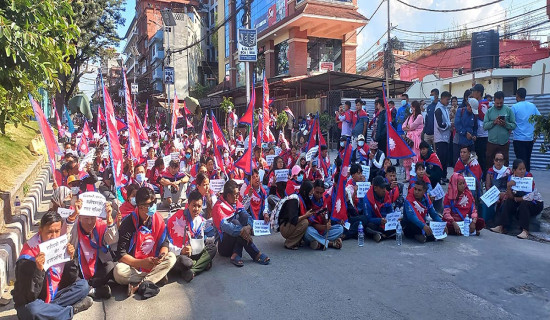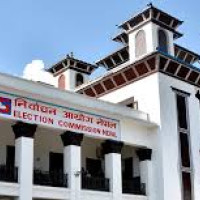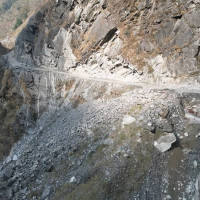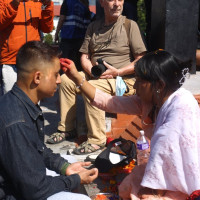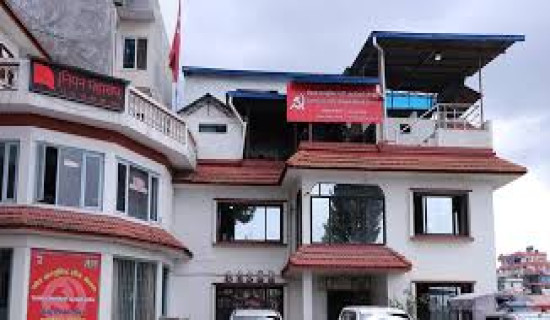- Saturday, 25 October 2025
Amalgamation of epochs of knowledge
Padam Sunder Joshi’s ‘Hiti Pranali’ launched
Lalitpur, July 7: An elongated stone spout protruding from the open mouth of the mythical Makar crocodile is what people think of when they think of Kathmandu’s traditional hitis. But that is only a narrow conception of what is, in fact, an elaborate system of urban water management, said scholar Padma Sunder Joshi.
As he presented at the launch of his book ‘Hiti Pranali’ here on Wednesday, acknowledging a hiti through the fountain, elaborate as they may be, would be extremely erroneous if not downright ignorant. For hitis are more than what we see; they are an intricate system of interconnected parts all working in tandem to bring water to our settlements. They are a comprehensive entity designed by our ancestor millennia ago to not only quench the thirst of their communities but also irrigate their fields, prevent waterlogging of their residences and maintain the health of the groundwater.
Yes, the Hiti Manga (the spout; a corruption of the name Hiti Makar meaning spouts featuring the Makar) is a part of hitis but so are the Hiti Gaa (the dug complex containing one or more Hiti Mangas), the Hiti Du (channels that bring water from the source to the fountains), Atha (structures to change the direction and level of water flowing to the spouts), Nabhimandal (intake structures installed at the underground water source), aquifer, ponds (built to recharge the aquifers) and the state canals (Rajkulos built to bring water to the ponds). Hitis are a living system, Joshi said.
At least, they were. A 2019 report by the Kathmandu Valley Water Supply Management Board recorded 573 hitis in the Kathmandu Valley. Of them, 280 have dried, 94 no longer exist and 42 have been totally destroyed with no trace remaining. Joshi also elaborated the reasons for this.
“The communal trusts established to maintain the hitis collapsed, the ownership of the water heritage was taken out of the hands of the locals, the construction of drainages and buildings damaged the water channels, wells and tube wells sucked the groundwater out of the aquifers and away from the hitis and the ponds were covered and built over,” he said, adding, “Haphazard urbanisation and rampant concretisation of surfaces has also depleted our water table.”
This is causing a unique paradox in our cities where the water sources are drying while the streets flood during rains.
However, Joshi is cautiously optimistic that some of the valley’s hiti systems can be revived. In Lalitpur, for instance, the reestablishment of the royal canal extending from Tikabhairav to Lagankhel will contribute to the revival of the Saptapatal Pokhari which in turn will restore water flow to the conduits of the inner cities. And if such revival efforts occur, Joshi’s book, published by Nepa~laya Publication, can serve as a reference book, a repository of knowledge that is worryingly linked to the mortality of the older generation.
And this is a heritage that deserves revival and preservation because it is an unparalleled achievement. As Joshi said, “The most ambitious drinking water projects of today are designed for 20 to 30 years. Our ancestors designed a mechanism that has been continuously providing water, with little human intervention, for over
2,000 years.”
Hiti is a uniquely Nepali system, a statement issued by the publisher on the occasion of the book launch ceremony quotes Joshi as saying, an amalgamation of the comprehension and capacity acquired and implemented over epochs. No one knows for sure when the notion of hitis as a tool for water circulation entered Nepal but historians agree that the concept was born during the era of the Gopal dynasty, implemented during the Kirant dynasty, developed by the Lichhavis and expanded by the Mallas.
It especially combines the knowledge of springs that Kirants had with the expertise of wells and underground water extraction that the Lichhavis brought. This is proven by the composition of the word ‘Hiti’ itself, the statement elaborates.
The term ‘Yi’ is related to the Nepal Bhasa word ‘Yechu’ which means clean. And ‘Ti’ or ‘Di’, in some Tibeto-Burman languages means water. This way, Yiti, which presumably evolved into Hiti, came about as a term to mean clean water.
Joshi, an engineer by profession, has taught at Tribhuvan University’s Institute of Engineering, was member-secretary of Kathmandu Metropolitan City’s City Planning Commission and the leader of the Kathmandu Valley Mapping Programme. ‘Hiti Pranali’ is Joshi’s first Nepali-language book. It has 342 pages and is priced at
NRs. 1,495.



